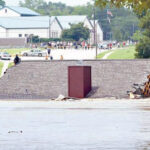History of the Texas Port Death Bridge Incident
The Texas Port Death Bridge case revolves around a tragic event on a bridge in a major Texas port, attracting attention for its mysterious and deadly nature involving several people. The incident has led to significant public concern and a thorough investigation, raising questions about infrastructure safety, accountability, and the effectiveness of local authorities in safeguarding the public.
Bridge Location and Details
The Texas Port Death Bridge Case centers on a fatal accident that drew national focus and prompted major conversations about bridge safety and regulation in Texas. The tragedy occurred on a busy bridge, highlighting issues with its condition and the broader oversight of aging infrastructure in the area.
Located in a busy Texas port, the bridge links two key economic zones and stretches over a significant waterway, accommodating both commercial and passenger traffic. Its design features a broad span supported by steel structures, and it undergoes regular maintenance to withstand heavy use and challenging coastal weather.
- The location is a critical junction for transport and shipping operations in Texas.
- The bridge’s design features multiple lanes and pedestrian walkways.
- Structural concerns prior to the incident had been reported by local authorities and commuters.
- The bridge stands as a key fixture in the region, both economically and symbolically.
Historical Significance of the Site
The Texas Port Death Bridge Case revolves around a tragic incident at a notable bridge in a Texas coastal port town, where multiple unexplained deaths have occurred over the years. The bridge, constructed in the mid-20th century, was originally intended to facilitate greater commercial activity in the region and support economic development.
- The bridge was a key infrastructure project that improved transportation links for local ports and industries.
- Several mysterious deaths and accidents have taken place on or near the bridge, leading to increased scrutiny and public concern.
- These deaths have been investigated for decades by both local authorities and federal agencies.
- The site has gathered historical significance due to its role in the community’s growth and the lingering questions attached to the case.
- Memorials and media coverage have kept public attention on the bridge, cementing its place in local lore and history.
Incident Details
The Texas Port Death Bridge case has drawn considerable attention because of the unusual circumstances involved. While information continues to surface, early reports suggest a tragic fatality took place on a major bridge near a well-known Texas port. Authorities are actively investigating the events leading up to the incident and examining potential contributing factors.
Date and Timeline of Events
The Texas Port Death Bridge case centers on a tragic incident that unfolded at the Port of Corpus Christi. The event began late in the evening on March 14, 2024, when authorities received reports of a vehicle plunging off the Harbor Bridge and into the waters below.
Preliminary investigations indicate that the incident began at approximately 10:45 PM. Witnesses saw the car speeding before it lost control near the middle of the bridge. Emergency crews arrived within minutes and began rescue efforts. Despite their quick response, the driver was declared dead at the scene, while a passenger was taken to a local hospital with serious injuries.
Officials shut down the bridge for several hours to perform forensic analysis and clear debris. The bridge reopened to traffic at 3:30 AM on March 15, 2024, following initial cleanup and safety checks. The incident led to an investigation into possible contributing factors, including road conditions, vehicle status, and the involvement of intoxicants.
Individuals Involved
A fatal accident on a bridge near a major Texas port is at the center of the Texas port death bridge case. According to early reports, the incident happened late at night when a vehicle lost control and crashed into part of the bridge, leading to severe damage and a rapid emergency response.
The individual at the center of the case was identified as a local port worker, whose duties often involved overnight shifts and maintenance tasks on the bridge. Authorities responded swiftly, and the individual’s family was notified shortly after confirmation of the fatality. Witnesses included other port employees and the bridge supervisor, all of whom provided statements to investigators about the circumstances leading up to the event. Law enforcement officials, the port authority, and safety inspectors are jointly conducting a thorough review to determine factors such as structural integrity, adherence to safety protocols, and any external influences that may have contributed to the tragedy.
Investigation and Legal Proceedings
The Texas Port Death Bridge case has captivated the public, given its intricate investigation and notable legal proceedings. Officials are actively collecting evidence, questioning witnesses, and seeking clarity on the events of the tragedy. As the case progresses, prosecution and defense teams are gearing up to argue their positions, paving the way for a courtroom showdown that will decide responsibility and justice for those involved.
Police and Emergency Response
The Texas Port Death Bridge case drew significant public interest because of its enigmatic nature and the prompt action taken by law enforcement and emergency teams. Authorities responded quickly, initiating a thorough investigation to determine the truth and seek justice for those affected. Local police, aided by emergency personnel, meticulously collected evidence and offered support as events developed. This case underscored the importance of coordinated emergency responses and the challenges involved in legal processes surrounding deaths and possible criminal activity.
- Initial reports led to a rapid deployment of police and emergency personnel to the bridge location.
- Forensic teams collected evidence such as surveillance footage, witness statements, and physical traces from the site.
- Authorities conducted interviews with possible witnesses and reviewed river and port security protocols.
- The legal proceedings commenced soon after, as prosecutors, defense attorneys, and investigators collaborated to determine an accurate sequence of events.
- Legal proceedings are underway to assess the need for criminal charges and to hold all responsible parties accountable.
Autopsy and Forensic Findings
The Texas Port Death Bridge case sparked significant public and legal attention due to the mysterious circumstances surrounding the incident. Authorities launched a comprehensive investigation, involving local police, state agencies, and forensic experts. The scene was meticulously examined for evidence, and potential witnesses were interviewed to piece together the events leading up to the tragic occurrence.
Legal action began when early evidence suggested possible misconduct or carelessness. Both prosecution and defense engaged in extensive pre-trial arguments about which evidence and witness statements could be used. The court examined every aspect closely to guarantee a just and comprehensive trial. Meanwhile, the case attracted media attention and sparked debates about local safety standards.
The autopsy provided crucial insights into the cause and manner of death. Forensic pathologists conducted a detailed examination, noting injuries consistent with a fall from a significant height. Toxicology reports clarified the presence or absence of substances that may have contributed to the victim’s condition. Additional forensic findings included analysis of trace evidence from the victim’s clothing and the bridge structure itself, all of which played key roles in the legal deliberations and ultimate case resolution.
Charges and Arrests
The Texas Port Death Bridge case has drawn significant public and media interest owing to its alarming circumstances and the legal actions that followed. Authorities initiated a prompt investigation after the tragedy, dedicating substantial resources to reveal the facts and hold those accountable. The case’s legal proceedings have been closely monitored, highlighting both the gravity of the accusations and the judicial system’s handling of such incidents.
- Authorities quickly arrived at the scene, gathering evidence and interviewing witnesses to determine the events that led to the fatality on the bridge at the Texas port.
- Identification of Suspects: Through forensic analysis and surveillance footage, investigators were able to identify multiple suspects allegedly involved in the incident.
- Charges: Prosecutors issued formal charges ranging from manslaughter to reckless endangerment, reflecting the gravity of the reported actions and the evidence gathered during the investigation.
- Arrests: Law enforcement officers executed arrest warrants across multiple locations, detaining individuals linked to the case and ensuring they would face the justice system.
- Legal Proceedings: The defendants were brought before the court for initial hearings, where the charges were read, and bail considerations were determined, starting the complex process of legal adjudication.
Impact and Aftermath
The Texas Port Death Bridge case has deeply impacted the community, igniting extensive debate over public safety and legal responsibility. In response, officials, locals, and advocacy groups have confronted the consequences, focusing on both short- and long-term effects. This event has led to demands for policy reform and greater awareness, influencing the broader conversation on infrastructure safety in Texas.
Updates to Bridge Security
The Texas port death bridge case led to significant attention towards the vulnerabilities in local infrastructure and the pressing need for improved safety protocols. The tragedy sparked public outcry and prompted authorities to reevaluate existing security measures on bridges in the region. The incident became a catalyst for immediate and long-term changes aimed at preventing similar occurrences in the future.
- Security patrols and surveillance around major port bridges were heightened.
- Barriers and protective fencing were installed or upgraded to deter unauthorized access.
- Access points to the bridges were limited, with stricter controls and monitoring for vehicles and pedestrians.
- Collaboration between local law enforcement and port authorities was strengthened to ensure rapid response to potential threats.
- Mandatory regular safety audits and risk assessments were implemented to proactively identify and address vulnerabilities.
Legal and Policy Changes
The Texas Port Death Bridge case had far-reaching impacts not only on the local community but also on the broader transportation and legal landscape of the state. Following the tragic incident, public outcry intensified regarding infrastructure safety and the accountability of contractors and governmental bodies responsible for maintaining public works.
Following the incident, thorough investigations sought to uncover the causes and assign accountability. The state promptly launched safety audits of comparable bridge structures. Victims’ families, advocacy organizations, and community leaders insisted on openness and decisive action. Memorials and advocacy efforts intensified the demand for reform.
Legally, the incident triggered comprehensive policy reviews at both local and state levels. Lawmakers introduced new legislation mandating regular, independent inspections for all critical bridge infrastructure. Stricter penalties were established for negligence and failure to adhere to safety protocols. Additionally, the case prompted reforms in contractor vetting processes and increased public disclosure requirements, ensuring communities are informed about the conditions and ongoing maintenance of essential transport routes.
Ultimately, the Texas Port Death Bridge case served as a catalyst for sweeping changes in infrastructure management and legal oversight. By spotlighting fragilities and gaps in existing systems, it led to meaningful reforms designed to prevent similar tragedies and restore public trust in the safety of Texas’s transportation networks.




